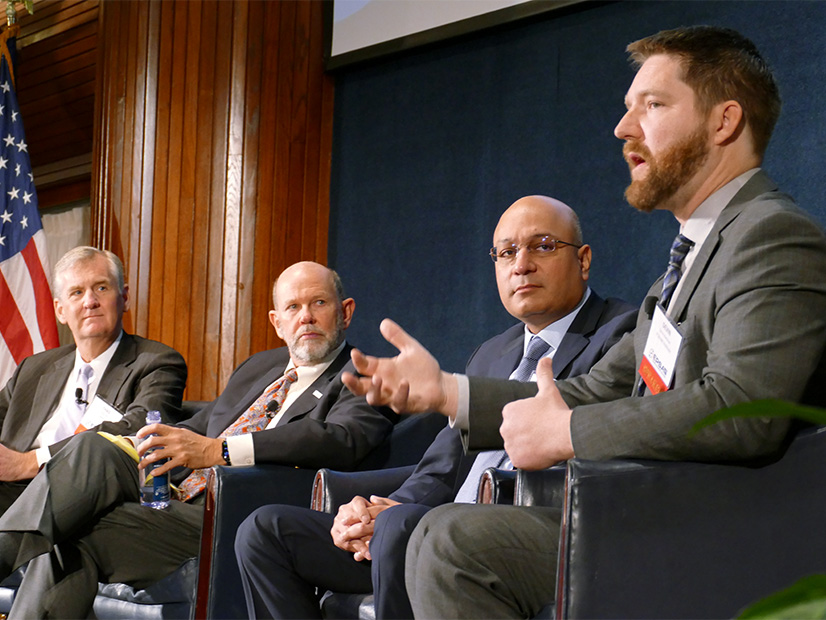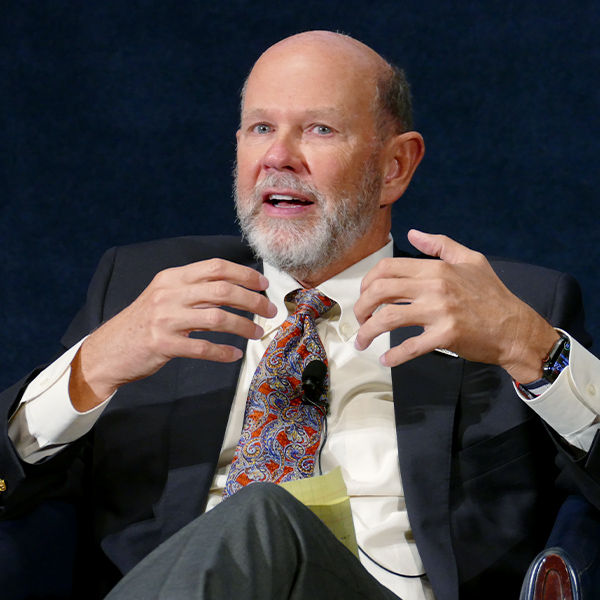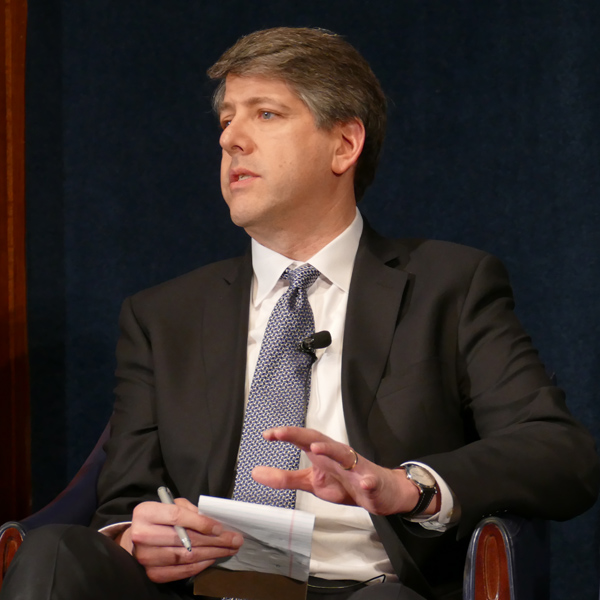
WASHINGTON — Extreme weather events during the last two years have brought “extraordinary clarity” about the reliability risks posed by the changing climate, NERC CEO Jim Robb said Tuesday.
 NERC CEO Jim Robb | © RTO Insider LLC
NERC CEO Jim Robb | © RTO Insider LLC
“These weather systems are … longer, deeper, broader,” Robb told the Electric Power Supply Association’s Competitive Power Summit, citing “heat domes” in the West and the February 2021 winter storm, named “Uri” by the Weather Channel. “And that’s a real problem, because utilities can’t rely as much on transfers [from other regions] to bail them out.”
NERC was able to identify generation that could have preserved ERCOT’s ability to serve load during Uri, “but we’d be wheeling it from peninsular Florida and Montana and places like that,” Robb said. “And the cost to build that transmission is ungodly.”
Uri resulted in several days of rotating blackouts in Texas to prevent a grid collapse, the largest manually controlled load shed event in U.S. history. It also showed that weather can cause outages to more than wind and solar generation. Natural gas-fired units represented 58% of all generating units that experienced unplanned outages, derates or failures to start, a joint FERC-NERC report concluded.
As weather challenges rise, the drive to electrify transportation and heating means the demand for reliability will only increase, Robb said. “Our tolerance for even momentary outages or any sort of disruption is going to go to zero very, very quickly.”
As a result, he said, “we really need much, much better situational awareness between the system operators, the generators and, importantly, the fuel suppliers.”
A common link in NERC’s assessments of major reliability events driven by weather — including the 2011 and 2018 cold weather events — is that “the system operator and the generators just didn’t know whether their fuel was going to show up or their plants could perform. So, the operators are scrambling to make decisions in real time that they should have had the ability to plan for,” Robb said.
He also repeated his call for a different “mindset” on reliability and resource adequacy, saying the calculation of peak annual load plus reserve margin is no longer sufficient because of intermittent generation and gas plant fuel risks.
Concerns are most acute in California, Texas and New England, “the three hotspots for how the world has evolved,” Robb said. “This will be coming to the theater near you soon. It may take a while, but the dynamics are clearly there.”
 Paul Sotkiewicz, E-Cubed Policy Associates | © RTO Insider LLC
Paul Sotkiewicz, E-Cubed Policy Associates | © RTO Insider LLC
Also speaking at the conference, Paul Sotkiewicz, president of E-Cubed Policy Associates, said ERCOT needs “some sort of reliability call option.
“I’m not going to use the term ‘capacity market’ because that’s a dirty word in Austin. … But the whole point is that you need some sort of reliability call option to say, when the system gets to a certain condition — I don’t care if it’s summer peak, winter peak, the shoulder period — if I need you, I can call on you.”
Calpine CEO Thad Hill echoed Robb’s concern, saying the Biden administration and some state energy policymakers are causing “changes to major tariffs in the markets, where it’s about emissions first, cost second and reliability third.”
Obligation to Perform
Robb said the wholesale markets must redefine generators’ “obligation to perform.”
NERC learned that many generators shut down by Uri had made “a pure economic decision” not to winterize, Robb said.
“They said, ‘Look, it’s not worth it for me to invest in this amount of winterization for this unit because I just won’t show up that day. And sure, I may forgo a day of very high prices, but I don’t [think] the probability of that happening justifies the investment.
“We have to create the proper set of incentives and … penalties so that a generator saying, ‘I’ll be there’ — they’ve got to be there. And if they’re not, I’m sorry, they should get whacked on the knee. And they should be incented to be there under a broader range of conditions than we might have thought of before. Because the tails in the distribution of outcomes — these tails are becoming really, really important.”
Educating Rate Regulators
Devin Hartman, energy and environmental policy director for R Street Institute, said NERC needs to help educate policymakers about the need for flexible natural gas units and services such as ramping. (See related story, EPSA Members Renew Call for Carbon Price; See Long ‘Bridge’ for Gas.)
State utility regulators “are really struggling with prudency decisions now. They’re looking at this and saying, ‘We don’t even understand you’re talking about ‘ramp,’” Hartman said.
“This has never been classically built into [integrated resource plan] considerations. And they’re really struggling to kind of operationalize it at that level. Increasingly, reliability cost and environmental performance are a function of regional portfolio conditions. And that means … you actually have to have enhanced information flows and better coordination.”
 Arnie Quinn, Vistra | © RTO Insider LLC
Arnie Quinn, Vistra | © RTO Insider LLC
Arnie Quinn, vice president of FERC-jurisdictional markets for Vistra (NYSE:VST), said the grid is unlikely to see “reliability catastrophes” as a result of the transition to renewables.
“I think it will be more likely that we will see a lot of resource adequacy RMRs [reliability-must-run agreements] and fuel security RMRs and a bunch of other little RMR actions and things that bury costs,” he said. “And quietly, costs will go up in a way that’s very non-transparent.”
Glass Half Empty
Asthana and Hartman expressed optimism that RTO stakeholder processes will develop the market designs needed to support efficiency and reliability.
Robb was less confident.
“We got to get the stuff figured out now so that as we redevelop the system over the coming 10, 20, 30 years, we’re leaving something behind that we’re going to feel proud of,” he said. “Right now, it’s not clear to me that we’re going to get there. You guys are optimistic. I’m paid to be the [glass] half-empty guy.”


